 |
 |
 |
Our route - I:
15.02.03 - 16.02.03:
Gallipoli
17.02.03 - 26.02.03:
Istanbul
27.02.03 - 28.02.03:
Yalova
01.03.03 - 02.03.03:
Bursa
03.03.03 - 04.03.03:
Appolonia
Kus Cenneti
05.03.03:
Troja
06.03.03:
Pergamon
07.03.03:
Selcuk
Ephesus
08.03.03 - 14.03.03:
Kusadasi
15.03.03 - 16.03.03:
Pamukkale
17.03.03:
Nysa
18.03.03:
Didyma
Milet
Herakleia/Latmos
19.03.03:
Milas
20.03.03 - 29.03.03:
Dalyan
29.03.03 - 02.04.03:
Oludeniz
03.05.03:
Kekova
04.05.03 - 12.05.03:
Olympos
13.04.03:
Anamur
15.04.03 - 16.04.03:
Aksaray
17.04.03 - 23.04.03:
Cappadocia
24.04.03 - 26.04.03:
Kayseri
Sivas
27.04.03:
Tokat
28.04.03 - 07.05.03:
Trabzon
Sumela
Yomra
Our route - II:
14.05.03 - 16.05.03:
Hopa
17.05.03:
Rize
18.05.03 - 19.05.03:
Trabzon
20.05.03:
Samsun
21.05.03 - 22.05.03:
Alacahoyuk
Hattusas (Bogazkale)
23.05.03 - 28.05.03:
Ankara
29.05.03:
Aksaray
Payas
30.05.03:
Antakya
Our route - III:
18.07.03 - 27.07.03:
Antakya / Belen
28.07.03:
Soganli (Capp.)
29.07.03 - 31.07.03:
Ortahisar (Capp.)
01.08.03 - 02.08.03:
Goreme (Capp.)
03.08.03 - 07.08.03:
Ankara
08.08.03 - 12.08.03:
Soguksu nat.park
13.08.03 - 14.08.03:
Ankara
16.08.03 - 20.08.03:
Trabzon
21.08.03:
Erzurum
22.08.03 - 24.08.03:
Van
25.08.03:
Ahtamar Adasi
Tatvan
26.08.03 - 29.08.03:
Nemrud Dagi
30.08.03 - 01.09.03:
Dogubayazit
Our route - IV:
26.05.04 - 27.05.04:
Dogubayazit
28.05.04 - 29.05.04:
Erzincan
30.05.04:
Shivas
31.05.04:
Gerede
01.06.04:
Edirne
|
|
|
 |
| Turkey |
 |
 |
 |
 |
 |
 |
On this page, we (will) describe our experiences in Turkey.
Apart from the travelogue for this country
you will also find a number of links to useful sites,
ranging from general information to embassy homepages.
Content:
Part 1: Winter (15.02.03 - 07.05.03)
Part 2: Spring (15.05.03 - 30.05.03)
Part 3: Summer (07.03 - 08.03)
Part 1: Winter (15.02.03 - 07.05.03)
Written by: Coen
On the 15th of February we approached the border to Turkey. EU soldiers are showing off doing military dances while the Turkish soldiers looked at them with bored faces, smoking a cigarette.
In order to pass the border, we had to go to cabin no. 1, where they told us to get a visa in the big building behind it, then get a stamp at cabin no. 2 and get back to show the stamp in cabin no. 1. The customs were in cabin no. 3. For 20 Euro they gave us a multiple entry visa for three months.
We entered Turkey with 1° C and a blue sky. The sloping, normally dry landscape was decorated with pieces of white snow. Because it had been -5° C that night, the ditches and lakes were deep frozen. It remembered us of a Dutch winter wonderland. Nothing oriental!
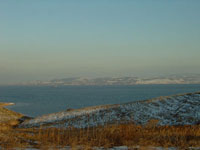 Over the magnificent peninsula Gelibolu (Gallipoli) we drove along the Dardanelles (Hellespont), the connection between the Mediterranean Sea and the Black Sea: A beautiful tour with the sloping snow covered mountains of Gelibolu on the one side and the narrow water street full of huge cargo ships on the other side.
Over the magnificent peninsula Gelibolu (Gallipoli) we drove along the Dardanelles (Hellespont), the connection between the Mediterranean Sea and the Black Sea: A beautiful tour with the sloping snow covered mountains of Gelibolu on the one side and the narrow water street full of huge cargo ships on the other side.
The first night we spent the night on a small market square. While from the minaret people are called for sunset prayer, we have a goulash on the stove...
The next day we visited the battle fields of Gallipoli. During WWI a heavy battle was being fought between the Britons, the Australians, the New Zealanders and the French on the one side and the Turks on the other side. The Turks under Mustafa Kemal Ataturk, founder of the modern Turkey, managed to stop the allied forces. It was a very impressive tour on the island. On a few km² more than 500.000 soldiers gave their lives for a war that is hardly mentioned in our history books.
We have spent the evening in a little Turkish bar. It really is a man's society with posters of half-naked women on the wall and only a man's toilet (already with water bowl). The Turks however, were very friendly and hospitable.
 On our way to Istanbul the beautiful route turned from paved into unpaved into a stone avalanche, so we had to turn around. According to a bus driver the road was closed but of course we couldn't read the signs, which were all in Turkish. Now we had to make a huge detour through the mountains. The badly paved winding road was partly packed with blown up snow and at a certain point a garage truck was waiting like a vulture for cars to get stuck in the snow... After a whole day of driving, we were still 60 kilometers away from Istanbul. In a village we found a small Turkish restaurant and after some communication problems, we had a splendid kebab. The Turks are so polite!
On our way to Istanbul the beautiful route turned from paved into unpaved into a stone avalanche, so we had to turn around. According to a bus driver the road was closed but of course we couldn't read the signs, which were all in Turkish. Now we had to make a huge detour through the mountains. The badly paved winding road was partly packed with blown up snow and at a certain point a garage truck was waiting like a vulture for cars to get stuck in the snow... After a whole day of driving, we were still 60 kilometers away from Istanbul. In a village we found a small Turkish restaurant and after some communication problems, we had a splendid kebab. The Turks are so polite!
When I went to the bakery to get some bread, the baker knew from the barber that our car was parked around the corner at the police station. They even waved us good bye.
We drove on to Istanbul and managed to find a parking place in the heart of the center. In the end we would stay here for 8 days.
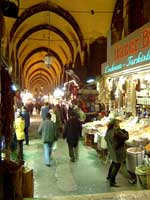 Istanbul / Constantinople / Byzantium, what a wonderful and dazzling city. We are glad to be here!
Istanbul / Constantinople / Byzantium, what a wonderful and dazzling city. We are glad to be here!
There are 16 million people living in Istanbul, that is as many as in the whole of Holland! Everywhere are people, little shops and medieval areas. All sorts of sheds selling everything you can imagine. The first day we got lost in the little narrow streets and we simply did not want to find our way back.
The second day started with snow. It would be snowing until the day we would leave Istanbul. It snowed day and night, day and night...
We walked to the Dolmabahce palace, where the sultans lived in all their wealth until Kemal Ataturk kicked them out in 1920 and moved in himself. One room is more beautiful than the other, stuffed with gifts from all over the world. After a tour through this magnificent Versailles of Turkey, we were taken to the living parts of the sultans harem. The harem consisted of the mother of the sultan, his wives, the daughters, the sisters, the nieces and the servants. All together a few hundred women!
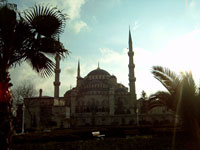 After having a tea in a little tea-house with wall hangings we went to the Egyptian bazaar and strolled along the little sheds selling everything: spices, sweets, nuts, fruit, watches, etc, etc. Here you will find articles that are long lost in our country, for example the mechanical (hand) mixer. We finished the day with dinner on low chairs in a small Turkish restaurant.
After having a tea in a little tea-house with wall hangings we went to the Egyptian bazaar and strolled along the little sheds selling everything: spices, sweets, nuts, fruit, watches, etc, etc. Here you will find articles that are long lost in our country, for example the mechanical (hand) mixer. We finished the day with dinner on low chairs in a small Turkish restaurant.
The following days we visited a.o. the Hagia Sophia. This famous Byzantine church, later turned into a mosque, is amazingly huge. This sun shines in white beams through the windows in the dome and parts of the ceiling and the walls are covered with wonderful golden mosaics. Once the interior must have been fully covered with golden mosaics.
After the historical museum with the Alexander (the Great) sarcophagus from Lebanon, we had a closer look at the Blue Mosque of Istanbul. In the center we were haunted by shoeshine men, postcard sellers, people selling caps, socks, perfume and even tops.
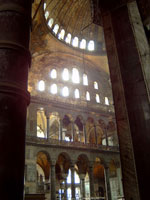 A boat trip on the Bosporus (sea street from the Marmara sea to the Black Sea that forms - together with the Dardanelles - the separation between Europe and Asia) was part of our program. After waiting long enough we automatically got one third off the price. We floated along the European banks, along the marvelous castles with their terraces and along the Asian banks, with the little wooden houses. It was freezing cold!
A boat trip on the Bosporus (sea street from the Marmara sea to the Black Sea that forms - together with the Dardanelles - the separation between Europe and Asia) was part of our program. After waiting long enough we automatically got one third off the price. We floated along the European banks, along the marvelous castles with their terraces and along the Asian banks, with the little wooden houses. It was freezing cold!
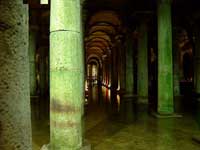 Absolutely worth visiting is the Cistern - the sunken palace - originally built as a water reservoir for the many sieges of Constantinople. It is a huge underground antique arcade, filled with water. There are 336 pillars in rows and the different lights gives it a fairytale impression.
Absolutely worth visiting is the Cistern - the sunken palace - originally built as a water reservoir for the many sieges of Constantinople. It is a huge underground antique arcade, filled with water. There are 336 pillars in rows and the different lights gives it a fairytale impression.
The great bazaar we visited afterwards, which was high time! Our last jeans are full of holes so...we bought 4 Levis 501 for 60 Euro! It is a shopping paradise for the western tourist.
On one of the last days we introduced a mosque-day: Ruestem Pasa, Sehzade, Bayazit and Suleymaniye. Shoes off, shoes on. Headscarf on, headscarf off.
The following day we took the train to the beginning of the city wall of Constantinople. We had read so much about it and we have seen so many paintings of it in different European countries, that we were happy to finally see it for real. It was a long tour along, over, under and through one of the most impressive city walls in the world. It was interesting to see how for ages the people lived with and in (vagabonds and stray dogs) the wall. At the end of our trip we looked like wild snow men.
That night we finally met Wytske and Martijn after so many emails and try-to-meet-but-not-succeed actions. We met them in Poland and they are traveling to Africa. It was great, we had two days to chat and talk, which was not nearly enough. We will meet again in their hometown Groningen...
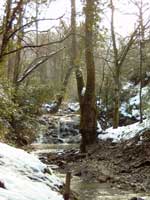 We left Istanbul and after passing the Bosporus bridge were in Asia for the first time in our lives.
We left Istanbul and after passing the Bosporus bridge were in Asia for the first time in our lives.
After 8 days Istanbul in the snow, we sat out our cold in the Turkish thermal bath in Yalova. In this 600 years old Ottoman bath, wonderfully situated in the forest, we spent 2 days. After the Turkish steam bath followed a cold bath and then a dive in the 45°C hot thermal water. After a cup of tea in the relaxing rooms, we started it all from the beginning again. For dinner we had fresh trout for nearly nothing. After these 2 days we were both healthy again!
Time to get to Bursa. Bursa was the last stop of the old Silk route from China to Europe. We visited the old caravan building and the mosque. The sun is shining! From the citadel we had a great view over city. It is beautifully situated between the snowy mountains. For dinner we had a kebab and when the television reported that the Turkish parliament voted against further deploying of American troops in Turkey, little parties started spontaneously everywhere.
The next day we went to the ski-center of Bursa with 30 persons in a far too small old gondola, gliding high above the snowy trees. Upstairs, Bursa leaves Austria nowhere; luxury hotels, modern ski-elevators, etc. Before I knew it, I had rented a pair of skies and a card for the elevator and I whizzed off the piste for the first time in years. It was a great day!
The man renting the skies came from Kirgistan and was delighted that we are going to Russia. We were invited for coffee and we chatted with hands and feet.
On our way to Kus Cenneti we made a little excursion to Appolonia. The time seems to have stopped a hundred years ago in this beautiful little village on a peninsula in the Apolyont lake. The fishing boats lie in the fringes of reeds and on the market square Turkish men had their tea under the friendly spring sun. We were immediately invited for a tea.
Along the lake we drove to Kus Cenneti (bird paradise). We spent the night on the parking place and a dog watched over us. The next morning we went to the bird reservation. After doing some bird watching in the observation room, we climbed in the observation tower armed with our binoculars. We observed a colony of cormorants, prey birds and pelicans.
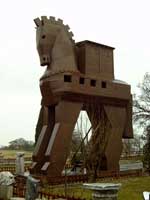 After a long trip through the splendid and clean landscape we drove to Troja. At night we were invited for a glass of wine by the owner of a gift shop and the next morning we went to Troja. From the entrance, where there is a replica of the huge Trojan horse, a tour took us along the excavations of the 9 different cities built on each other. The eldest dates from 3000 B.C. and the "youngest" was built by the Romans. We looked for old coins for a while but we were not lucky.
After a long trip through the splendid and clean landscape we drove to Troja. At night we were invited for a glass of wine by the owner of a gift shop and the next morning we went to Troja. From the entrance, where there is a replica of the huge Trojan horse, a tour took us along the excavations of the 9 different cities built on each other. The eldest dates from 3000 B.C. and the "youngest" was built by the Romans. We looked for old coins for a while but we were not lucky.
The same day we drove to Bergama where we parked in a little street. At 10 pm, a Turkish boy knocked on our door and brought us olives and cheese. "Turkish hospitality", he said, but he would appreciate it if we came to visit his carpet shop...
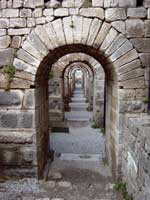 We woke up early to see the excavations of Pergamon which was the capital of the antique Pergamene empire, an important civilization (they invented f.e. the parchment). A lot of the city is well preserved, e.g. a beautiful white marble Roman temple.
We woke up early to see the excavations of Pergamon which was the capital of the antique Pergamene empire, an important civilization (they invented f.e. the parchment). A lot of the city is well preserved, e.g. a beautiful white marble Roman temple.
On the way to Ephesus we passed Izmir, the city that was hit by an earthquake in 1999, killing more than 50.000 people. Everywhere you can see newly built houses, empty squares and ruins.
Spring has started. It is 17°C and the sky is blue.
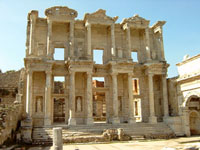 In Ephesus we visited the marvelous Roman site. In 1000 B.C. around 200.000 people lived here. Fascinating is the beautiful Celsus-library; a two story facade made of marble pillars and nicely carved reliefs. There also was a huge, well preserved theater. I strolled around the ruins of the old Byzantine houses and with a bit of fantasy, you can find yourself 3000 years back in time.
In Ephesus we visited the marvelous Roman site. In 1000 B.C. around 200.000 people lived here. Fascinating is the beautiful Celsus-library; a two story facade made of marble pillars and nicely carved reliefs. There also was a huge, well preserved theater. I strolled around the ruins of the old Byzantine houses and with a bit of fantasy, you can find yourself 3000 years back in time.
At the weekly market of Selcuk, we did some shopping. The nicest vegetables and the best fruit was being sold by interesting native farmers.
To celebrate the fact that spring has started and for us the four winter months in the camper van are over, we decided to stay in Kusadasi (tourist place at the coast) and stay on a camping site for a few days. We found a wonderful camping site. On this dream-camping site, we do nothing else than sitting in the spring sun, grill sardines and enjoy being outside.
Turkish Riviera, Anatolian highlands and black sea coast
On the 15th of March, we drove to Pamukkale (Turkish for "cotton castle"). These unique limestone basins arose as warm thermal water, containing limestone, cooled down and deposited the limestone in the basins.
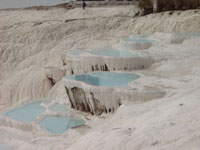 We walked bare-foot uphill through the warm basins. Fortunately the hotels uphill are torn down so the damaged and gray basins can grow and become white again. We needed two days for this huge and fantastic miracle of nature. I am very curious how the Pamukkale basins look like in about five years, when they are grown again.
We walked bare-foot uphill through the warm basins. Fortunately the hotels uphill are torn down so the damaged and gray basins can grow and become white again. We needed two days for this huge and fantastic miracle of nature. I am very curious how the Pamukkale basins look like in about five years, when they are grown again.
As a bonus you will find the remains of the ancient city of Hierapolis on top of the Pamukkale mountain. These are so well preserved that you will find yourself 2000 years back in time, walking over the main street, looking into the little shops and getting dizzy in the big theatre.
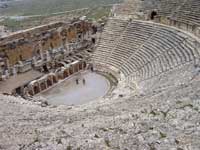 On our way to Nysa, the police got us out of our bed at 5:30 am because a market was going to be built up at the square where we were parked that night. This happens quite often lately. We took this opportunity the next morning and bought some fine Turkish stuff. Again it was a real Walhalla of vegetables, dairy products and cakes. In Nysa we visited the Roman agora, the ruins of the bath house and the town hall. Except for a Turk with a packed donkey, we were alone.
In Didyma we stopped to visit the Apollo temple, the main competitor of the Greek Delphi-oracle. The huge pillars showed us how big it used to be.
On our way to Nysa, the police got us out of our bed at 5:30 am because a market was going to be built up at the square where we were parked that night. This happens quite often lately. We took this opportunity the next morning and bought some fine Turkish stuff. Again it was a real Walhalla of vegetables, dairy products and cakes. In Nysa we visited the Roman agora, the ruins of the bath house and the town hall. Except for a Turk with a packed donkey, we were alone.
In Didyma we stopped to visit the Apollo temple, the main competitor of the Greek Delphi-oracle. The huge pillars showed us how big it used to be.
Because we had not seen enough excavations yet, we drove to Milet. This Ionic coast town lost its importance when the coast line moved back so the city was abandoned. What was left were the remains of the old harbor, a sunken agora and a beautiful theatre.
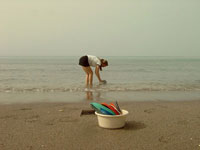 Through the beautiful Turkish landscape we drove to Herakleia, at the mountain Latmos. Rough, rocky mountains with steep tors and olive trees on the hills. Herakleia with its Byzantine ruins and city wall is nicely situated at the foot of the mountain Latmos and from there you have a nice view over the lake.
Through the beautiful Turkish landscape we drove to Herakleia, at the mountain Latmos. Rough, rocky mountains with steep tors and olive trees on the hills. Herakleia with its Byzantine ruins and city wall is nicely situated at the foot of the mountain Latmos and from there you have a nice view over the lake.
When we drove into the village, Turkish women came running along to sell their crochet works and only let lose when we bought something. We are now in proud possesion of a crocheted fish and a Mecca cap.
For a free camping site we had to pay with buying a pair of crocheted socks from the mother and it was not easy to get rid of the nephew who was selling trekking tours through the region.
From here we drove over a high mountain ridge and we descended via a steep serpentine road to the little village Dalyan at the Dalyan-delta, famous for its water turtles (caretta caretta) and its rock graves.
When we wanted to leave the next morning, a break cylinder turned out to be broken and we could not break anymore. Inshallah!
When a big black Chevy ('68) stopped and a Turk asked us in German if we needed some help, this was the beginning of a week full of surprises. Yalcin, who lived in Germany for 25 years, helped us to get the brakecilinder repaired. He offered us that I could build the cylinder back in on his farm. He also offered us one of the many rooms with bath and we stayed a whole week with this family, containing of father Yalcin, son Butc, daughter Ella and many friends. Furthermore a monkey, a parrot, 2 horses, many sheep, dogs and 50 cows lived on the farm.
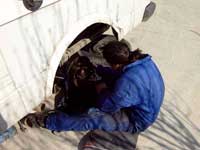 The monkey (kept on a leash) watched me repairing the car. Because the monkey fleas everything that is living, it should be kept away from the chickens because it strangled them in the past during a fleeing session.
The monkey (kept on a leash) watched me repairing the car. Because the monkey fleas everything that is living, it should be kept away from the chickens because it strangled them in the past during a fleeing session.
We helped son Butc with the business plan of his future restaurant and the first nights I was being introduced in the delights of drinking Raki (anis liquor). Yalcins friends Nasif and Soner were present at all of these occasions.
Yalcin took us to several typical Turkish restaurants with tables full of delicacies, local entourage and Turkish music.
A few days later we drove with Yalcins boat into the Dalyan delta. We passed the rock graves and from the foredeck we were lucky the see some water turtles (80 x 80 cm). The final purpose of this trip was a termalbath with 40°C hot water and a mud pool. We smeared each other full of mud and we looked like mud puppets.
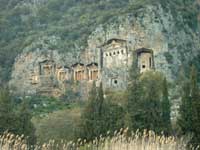 In honor of his guests, Yalcin had slaughtered a lamb. In a shed on the farm in front of the fireplace we had a medieval Burgundy-like eating festival with lamb legs, roasted potatoes, unions and huge garlic (and much Raki...)
With Ella we did some sightseeing and we discovered a big colony of land turtles, taking care of their next generations.
In honor of his guests, Yalcin had slaughtered a lamb. In a shed on the farm in front of the fireplace we had a medieval Burgundy-like eating festival with lamb legs, roasted potatoes, unions and huge garlic (and much Raki...)
With Ella we did some sightseeing and we discovered a big colony of land turtles, taking care of their next generations.
On the way to the weekly market on Saturday, 20 chickens were thrown into the trunk of the car. Half an hour later, Dorrit and I were selling chicken on the Turkish market....
As a good bye dinner, Yalcin had slaughtered chicken and Nasif and his wife had prepared them deliciously.
The next morning we said goodbye to Yalcin, Ella and Butc after a fantastic week in Dalyan.
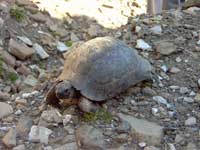 Before we drove any further, we first had an extensive tea with Harry and Monique from The Hague. They were on their way back from a long journey in Africa. They drove east and we drove south, in direction Fetiye.
Before we drove any further, we first had an extensive tea with Harry and Monique from The Hague. They were on their way back from a long journey in Africa. They drove east and we drove south, in direction Fetiye.
The first stop was Oludenis, the most beautiful beach of Turkey. Supposedly, the color turquoise is originally from here. The white beaches and the clear sea are surrounded by deep-green hills, making the sea look turquoise.
On a camping site we spent 3 cosy days and enjoyed the sun and the beach. We bbq-ed every day and exchanged travel stories at the campfire with Nico and Miny from Drenthe (Holland), Bernd and Sabine from Ulm and Ralf from Ravensburg (Germany).
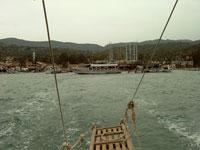 We left the camping site and drove to the excavations of Xantos, the old capital of the Lycian empire. It had pilargraves and beautiful mosaics. Then we drove 30 kilometers up and downhill on a small road to Kekova. Here a German woman asked us if we wanted to join them on their already chartered ship to the island. Of course!
We left the camping site and drove to the excavations of Xantos, the old capital of the Lycian empire. It had pilargraves and beautiful mosaics. Then we drove 30 kilometers up and downhill on a small road to Kekova. Here a German woman asked us if we wanted to join them on their already chartered ship to the island. Of course!
First we drove to an island with a big castle on a hill, surrounded by sarcophaguses. From here we had a nice view over the costal area. Then the boat took us to the island Kekova and the sunken city. In the 2nd century BC the whole city slid into the sea because of an earthquake. The shipper maneuvered the boat over the plateaus and through the windows in the floor we could see the ruins of the houses, the fragments of pottery and other objects.
After we returned from Myra, the city where St. Nicolas was bishop, we met Ralf (with his dog Lilly) from Ravensburg for the third time. We decided that this could not be a coincident and we spend nine fantastic days together.
The first two days at the beach a la Robinson Crusoe, then a day at a riverbed with a grill oven made by Ralf and 30 cm lamb skewers made by me.
 The third day we pulled our campers up a mud path and we found a nice place with view over a Laguna bay. Here we stayed two days together with Alessandro and Natasha from Switzerland.
The third day we pulled our campers up a mud path and we found a nice place with view over a Laguna bay. Here we stayed two days together with Alessandro and Natasha from Switzerland.
Together with Ralf we drove to Antalya but this was very touristy. We decided to exchange Antalya for a place in nature and spend the night on a riverbed with pebble stones, roaring frogs and beautiful green mountains around us. The next day we visited the best remained Roman theatre of Aspendos and after driving a long time over a sand track we found a beautiful place at the Manavgat lake. Here we spend two days fishing and bbq-ing. Unfortunately I broke a tire on a sharp stone.
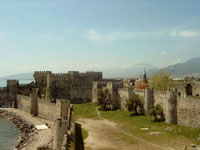 The next morning we said goodbye to Ralf and Lilly and we drove to Anamur through the beautiful and deserted mountains with banana plantations (and lovely ripe bananas for sale) everywhere. In Anamur we visited the Playmobil castle with its 39 towers, built by the Romans and perfectionized by the Selchuk (forerunners of the Ottomans). A few towers could be visited and we were amazed by the 20 cm huge lizards lying in the sun. In the castle moat lots of water turtles were swimming.
We continued our tour through the mountains (with raging and dangerously overtaking trucks and busses) and drove in direction Mersin. The public opinion towards George W. Bush had changed in a positive sense which meant we were in the Kurdish part of Turkey.
The next morning we said goodbye to Ralf and Lilly and we drove to Anamur through the beautiful and deserted mountains with banana plantations (and lovely ripe bananas for sale) everywhere. In Anamur we visited the Playmobil castle with its 39 towers, built by the Romans and perfectionized by the Selchuk (forerunners of the Ottomans). A few towers could be visited and we were amazed by the 20 cm huge lizards lying in the sun. In the castle moat lots of water turtles were swimming.
We continued our tour through the mountains (with raging and dangerously overtaking trucks and busses) and drove in direction Mersin. The public opinion towards George W. Bush had changed in a positive sense which meant we were in the Kurdish part of Turkey.
At the caves of Cehennem we stopped to visit "heaven" and "hell". These are huge caves with collapsed ceilings. The "hell" is 50 m broad and 128 m deep and according to Greek mythology a dragon with 100 heads was prisoned here.
Because of the war in Iraq we decided not to go to Syria now. Instead, we are going to drive to the black sea coast and try to take the boat to Russia. To get to the inland however, we first had to pass the Taurus mountains.
After a heavy tour through these mountains, followed by a very bad road over the empty, bald plateau, we arrived in Aksaray, an old caravansary city. This is again a piece of real Turkey. No tourists but everywhere the little shops where everything you can imagine is being sold.
To celebrate we are on tour for exactly one year, we went to a nice Turkish restaurant. It feels like we are on the road for only a few weeks now, instead of a year. Time flies when you're having fun!
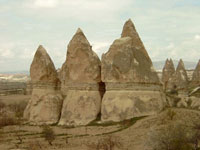 As an introduction to the "Cappadocia" area, we walked to the monastery valley in the little village Guzelyurt. This part of the village is partly cut out of the rocks. Here the people still live in caves with their donkeys, goats, staring children and women in nicely colored but awfully unflattering knickerbockers.
As an introduction to the "Cappadocia" area, we walked to the monastery valley in the little village Guzelyurt. This part of the village is partly cut out of the rocks. Here the people still live in caves with their donkeys, goats, staring children and women in nicely colored but awfully unflattering knickerbockers.
In the 8th century AD pursued Christians hacked out hidden churches in the rocks and decorated these with colorful frescos.
Another part of the village is completely underground with several rooms, stairs and storages.
In Ihlara we hiked two days in the wildly romantic Ihlara valley with a river twisting through the magnificent area. We followed the river banks and after clambering over the huge rocks, we passed several hidden churches and cave houses.
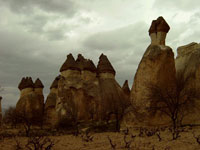 The next day we drove to Goereme, the center of Cappadocia. This area consists of many bizarre volcano stone forms. Worn out by erosion, there are pyramids, long high stones with hats, cones, tunnels and cones. Here we spent a whole week.
The next day we drove to Goereme, the center of Cappadocia. This area consists of many bizarre volcano stone forms. Worn out by erosion, there are pyramids, long high stones with hats, cones, tunnels and cones. Here we spent a whole week.
We spent the night with view over the rose valley (with rocks that looked like roses in the setting sun), we walked through the national park, we crambled over the rock dunes, visiting the marvelous painted rock cathedrals and we attended a procession with local costumes in honor of Kemal Ataturk.
After leaving Kayseri, "center of carpets and kilims" with its terrible and obtrusive carpet sellers, behind us, we drove a long tour through the inhospitable Anatolian highlands, finally arriving in Sivas.
Here the Turks still live very traditional and I could have spend days here. We visited the old caravansary, a 13th century praying house and a Koran school from 1371. Everywhere we drank tea, tried the local specialties and peeped at the local people living their lives.
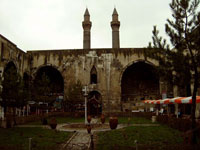 Just as nice as Sivas is Tokat. Also a very old original Turkish city with Selchuk and Ottoman bath houses, mosques and a quarter with timbered houses. In Tokat the parking guards wake you by bringing tea to your house/van.
Just as nice as Sivas is Tokat. Also a very old original Turkish city with Selchuk and Ottoman bath houses, mosques and a quarter with timbered houses. In Tokat the parking guards wake you by bringing tea to your house/van.
From Tokat we drove to the black sea coast. It was a severe mountain trip with very bad road stretches and cows and donkeys on the road. After the last 1700 meter-pass we finally arrived at the coast. On the road along the coast we passed many small fishing villages and we spent the night at a small harbor with multicolored fishing boats.
At night we watched dolphins playing until the red sun disappeared in the sea.
 Our final purpose for Turkey is Trabzon. From here we want to go to Russia. Unfortunately this took more time than expected. The Russian consul was replaced last year and the new one only gives Russian visa to Turkish citizens. Because our visa for Turkey expires however, we have to cross the border.
After a few days organizing and drinking much tea under the palm trees (This part of Turkey is subtropical), we decided to apply for our visa in Holland and insert a small holiday to Georgia.
Our final purpose for Turkey is Trabzon. From here we want to go to Russia. Unfortunately this took more time than expected. The Russian consul was replaced last year and the new one only gives Russian visa to Turkish citizens. Because our visa for Turkey expires however, we have to cross the border.
After a few days organizing and drinking much tea under the palm trees (This part of Turkey is subtropical), we decided to apply for our visa in Holland and insert a small holiday to Georgia.
Because we had to wait a few days, we left Trabzon and visited the beautiful Sumela monastery and hiked in the national park in the hinterland.
Because of the melting snow, little streams and waterfalls appeared and we spent some days at a little stream where the local inhabitants visited us every day and brought us fresh milk and hazelnuts (specialty of this region).
Back in Trabzon, the Russian visa in Holland seemed to be a problem too...
Fortunately we have an invitation to Russia, so we go to Georgia first and after that we will see...
Coen
If you want, you can click here to read more about our time in Georgia, before reading part 2 of our Turkey travelogue.
Part 2: Spring (15.05.03 - 30.05.03)
Written by: Dorrit
At the Turkish side of the Turkish-Georgian border we first had to visit a mobile hospital and fill in a form stating that we really did not have SARS. Also, the car had to be sprayed with disinfectant fluid. How this is going to keep SARS out of Turkey I don't know, but I guess you can never be too sure.
We were glad we could turn back the clock two hours again; it feels much more natural when it is light between 8 am and 9 pm instead of between 10 am and 11 pm. We settled at a camping place in Hopa, near the border, and worked at the travelogues for this website for two days.
In Rize, the epicentre of the Turkish tea production, we spend hours on the terrace of the medieval castle, which is sitting on a hilltop overlooking the city and the black sea coast. We drink litres of Rize-tea, absolutely the best tea I have ever drank in my life.
With high expectations we drove to Trabzon, but had to take in some disappointments there:
- Something seems to have gone wrong with the invitation for Russia, that a friend of Egor in Krasnojarsk was trying to get for us. He can hand in a new one at OVIR (the Russian visa officials), but that may take several weeks.
- We had sent our passports to a visa support company in Amsterdam to get our Russian visa, but although they can arrange 3 month business visa for EUR 500, they cannot guarantee that the border police will let us enter Russia when we are not really on a business trip.
Without this guarantee, we think we would be risking too much money if we would take the boat from Trabzon to Sochi (EUR 500 one way): if we are sent back at the border, we would lose EUR 1500 (2x boat and 2 visa).
- We may be able to buy an invitation via a travel agency in Ankara, but we will have to apply for our visa in person. This means we would have to drive all the way back to Ankara (about 1000 km).
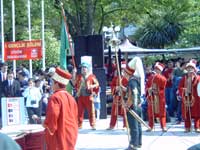 We will have to think of a new strategy. While drinking loads of tea on the city terrace of course. We decide to go to Ankara and try our luck there. Before leaving Trabzon, we attend a concert of a Ottoman band (complete with traditional clothes and medieval instruments) which is playing in honour of yet another Ataturk-memorial day. The evening is spent talking and eating out with a group of young Turkish men living in Trabzon.
We will have to think of a new strategy. While drinking loads of tea on the city terrace of course. We decide to go to Ankara and try our luck there. Before leaving Trabzon, we attend a concert of a Ottoman band (complete with traditional clothes and medieval instruments) which is playing in honour of yet another Ataturk-memorial day. The evening is spent talking and eating out with a group of young Turkish men living in Trabzon.
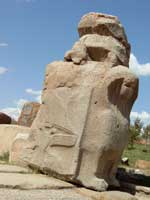 It takes us two days to drive to Ankara. Just east of the city lies Hattusas, the capital of the Hittite empire. 4000 years ago, the Hittites have ruled over an enormous empire, stretching from Anatolia (about 90% of Turkey) to the Middle East. In the south, it bordered the ancient Egypt empire. In Alacahoyuk there were some parts of the city wall left, including two big sphinxes at the city gate and some Egyptian style carvings on the city wall itself. In Hattusas we visited the graves of the kings, which had entire rows of gods hammered into the rock walls. We also climbed the city wall, which looked like a giant Egyptian pyramid from the outside. The city must have been impossible to take in its prime days. Here too it is especially the city gates that draw the attention: enormous sphinxes, lions and warriors of stone are watching the city gates. We are attacked by over 60 school children who all want to practice their 3 English sentences on us: what is your name, where are you from, how old are you. One of the little boys was blond and was called "yellow Mehmet" by the others. Cute.
It takes us two days to drive to Ankara. Just east of the city lies Hattusas, the capital of the Hittite empire. 4000 years ago, the Hittites have ruled over an enormous empire, stretching from Anatolia (about 90% of Turkey) to the Middle East. In the south, it bordered the ancient Egypt empire. In Alacahoyuk there were some parts of the city wall left, including two big sphinxes at the city gate and some Egyptian style carvings on the city wall itself. In Hattusas we visited the graves of the kings, which had entire rows of gods hammered into the rock walls. We also climbed the city wall, which looked like a giant Egyptian pyramid from the outside. The city must have been impossible to take in its prime days. Here too it is especially the city gates that draw the attention: enormous sphinxes, lions and warriors of stone are watching the city gates. We are attacked by over 60 school children who all want to practice their 3 English sentences on us: what is your name, where are you from, how old are you. One of the little boys was blond and was called "yellow Mehmet" by the others. Cute.
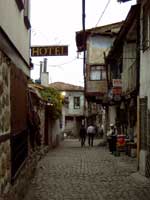 In Ankara I was amazed to see how modern both the city and its people are. Head scarves are an exception here, tight-fit t-shirts and bare legs aren't.
We spend a whole day searching for a travel agency specialized in Russia travels and when we finally find one, it appears that Russia has indeed tightened its rules and that getting an invitation for us is going to be difficult and expensive. We are starting to be a little bit fed up with all this. At one of the terraces, we spent a nice evening drinking tea with a Turk who exports bromium (an important ingredient for nuclear devices found only in Turkish soil) to countries like Iran and Japan.
In Ankara I was amazed to see how modern both the city and its people are. Head scarves are an exception here, tight-fit t-shirts and bare legs aren't.
We spend a whole day searching for a travel agency specialized in Russia travels and when we finally find one, it appears that Russia has indeed tightened its rules and that getting an invitation for us is going to be difficult and expensive. We are starting to be a little bit fed up with all this. At one of the terraces, we spent a nice evening drinking tea with a Turk who exports bromium (an important ingredient for nuclear devices found only in Turkish soil) to countries like Iran and Japan.
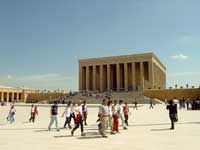 We visit the highlights of Ankara: the giant Ataturk mausoleum annex museum for the 80 years old Turkish republic. In front of the entrance there are over 30 touring cars and inside there are hundreds of school children. Impressive is the exposition covering the battle at Gallipoli (1915) and the wars against the Greeks in the 1920s. The Hittite-museum (Museum for Anatolian cultures) is splendid as well, featuring marvellous works of art from the Hittite empire and even from the stone age, some dating 9000 years back! At the entrance, we meet two elderly ladies from Germany, who appear to be living here for over 35 years now. We spend the rest of the afternoon chatting and drinking tea in lovely old tea houses in the medieval part of Ankara. This area looks like Tokat, full of Fachwerk houses in all kinds of colours, narrow cobblestone streets where sheep wool is drying in the sun and staring children. I call my mother, she has been operated today and all seems to have gone well. Great! I hope she will be able to walk again soon.
We visit the highlights of Ankara: the giant Ataturk mausoleum annex museum for the 80 years old Turkish republic. In front of the entrance there are over 30 touring cars and inside there are hundreds of school children. Impressive is the exposition covering the battle at Gallipoli (1915) and the wars against the Greeks in the 1920s. The Hittite-museum (Museum for Anatolian cultures) is splendid as well, featuring marvellous works of art from the Hittite empire and even from the stone age, some dating 9000 years back! At the entrance, we meet two elderly ladies from Germany, who appear to be living here for over 35 years now. We spend the rest of the afternoon chatting and drinking tea in lovely old tea houses in the medieval part of Ankara. This area looks like Tokat, full of Fachwerk houses in all kinds of colours, narrow cobblestone streets where sheep wool is drying in the sun and staring children. I call my mother, she has been operated today and all seems to have gone well. Great! I hope she will be able to walk again soon.
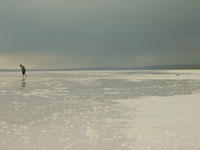 We decide to leave Russia be for now. We will keep the option of getting an invitation via Egor's friend in Krasnojarsk open, but since this will take a while anyway, we will spend the next two months in Syria and Jordan. By now the situation there is stable again. We get visa at the Syrian embassy in Ankara (same day service for EUR 35 per visa, plus EUR 15 for a letter of recommendation at the Dutch embassy - some embassies are cheaper though, the Slovakian does not charge anything for a letter of recommendation) and head south towards Syria. On our way we pass Tuz Golu, a 1500 km² salt lake which sides consist of a metres wide and -deep white and pink salt crust. A beautiful sight, and a good introduction to the dead sea! In Payas (just above the Syrian border) we have a look at a well preserved medieval caravan-station. That night proves to be an ordeal: it is very hot and damp, we can hardly breathe under our mosquito net. After a while a sandstorm rises, turning the sky yellow and creating a layer of dust on everything in the bus (including us), although all doors and windows are shut. In the morning the sky is still brown-yellow until it starts raining: thick brown mud drops. Ugh.
Our last stop before Syria is Antakya: a cute little Ottoman town with a nice museum of Roman mosaics. The road to the border winds its way through a beautiful area with Mediterranean trees and plants reminding me of southern Greece. Apparently there is not much traffic at this border post: the roads turns from a narrow asphalt road to an unsurfaced road to a dirt track. But nothing our VW LT cannot handle and around noon we arrive at the border. We are the only ones.
We decide to leave Russia be for now. We will keep the option of getting an invitation via Egor's friend in Krasnojarsk open, but since this will take a while anyway, we will spend the next two months in Syria and Jordan. By now the situation there is stable again. We get visa at the Syrian embassy in Ankara (same day service for EUR 35 per visa, plus EUR 15 for a letter of recommendation at the Dutch embassy - some embassies are cheaper though, the Slovakian does not charge anything for a letter of recommendation) and head south towards Syria. On our way we pass Tuz Golu, a 1500 km² salt lake which sides consist of a metres wide and -deep white and pink salt crust. A beautiful sight, and a good introduction to the dead sea! In Payas (just above the Syrian border) we have a look at a well preserved medieval caravan-station. That night proves to be an ordeal: it is very hot and damp, we can hardly breathe under our mosquito net. After a while a sandstorm rises, turning the sky yellow and creating a layer of dust on everything in the bus (including us), although all doors and windows are shut. In the morning the sky is still brown-yellow until it starts raining: thick brown mud drops. Ugh.
Our last stop before Syria is Antakya: a cute little Ottoman town with a nice museum of Roman mosaics. The road to the border winds its way through a beautiful area with Mediterranean trees and plants reminding me of southern Greece. Apparently there is not much traffic at this border post: the roads turns from a narrow asphalt road to an unsurfaced road to a dirt track. But nothing our VW LT cannot handle and around noon we arrive at the border. We are the only ones.
Dorrit
If you want, you can click here to read more about our time in Syria (and Jordan), before reading part 3 of our Turkey travelogue.
Part 3: Summer (18.07.03 - 02.09.03)
Written by: Coen
Back in Turkey again, this time from Syria. For the first time we paid bakshis (6 EUR) in Turkey to avoid our car being thoroughly searched. In Antakya we found a professional Volkswagen garage for a reparation on the car. It would take 5 days for the parts to arrive from Istanbul, so after we had another car tyre repaired in the car area, we drove to the seaside resort Samandag. Here we wanted to spend the 5 waiting days. It is a nice typical Turkish resort with bars, restaurants and Turkish music. Unfortunately it was so hot and humid that we decided to flee to the cool air of Belen at a height of 800 meter. We strand next to a Shell patrol station where we have a nice place to park with a fantastic view over the hills. We can use their shower, toilet and electricity, all for free! This turned out to be a nice midweek in a Shell-patrol station-biotope. With Ahmet and Leyla we drink a lot of tea and they cook us food, we feed the stray dogs, in the evenings we smoke water pipes with the Bulgarian truck drivers and Leyla invites us for a Turkish wedding. We party with them on the wedding and sleep in the village (where in the evenings a tank lorry comes to smoke out the malaria mosquitoes).
With a big box filled with tomatoes, cheese and olives pushed in our hands, we said goodbye and we drove back to Antakya.
The car was being repaired and while the motor was open anyway, we also had them change the belts. However, the actual problem was not solved. We made a big scene and in the end only paid for the parts.
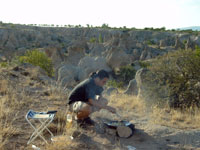
To get our visa for Iran, Pakistan and India we had to go to Ankara and because last spring we enjoyed Cappadocia very much, we decided to stay here a few days on our way to Ankara. In Ortahisar we stayed on a fantastic, cheap and new camping site (Kaya) and Dorrit washed (for the first time in a long period) 9 machines full of clothes.
In Goreme we walked some nice walking tours and we did a few days camping at a marvellous spot all alone on a mountain, surrounded by sandstone cones, with a nice view over the Cappadocian landscape.
After arriving in Ankara we applied for our visa and to bridge the 10 days waiting time we drove to a national park north of Ankara. We drove deep into the forest and we stayed at a romantic spot along a river stream with big, moss covered stones and many wild boars (nobody likes them here ;-). Much walking, bbq-ing and camp firing. It started raining two days and two nights and the path turned into a small mud river. We almost gave up all hope of getting out of the forest in time but finally the sun came out again (as usual) and we could leave the forest and go back to Ankara. We collected our visa and after 5 days running around in the city and having nice food and waterpipe at the lovely terraces of Ankara, we drove to Trabzon in two days.
In Trabzon we stayed 4 days and we spent a lot of time with our friend Suleyman and his comrades. From Trabzon we drove through the mountains to Erzurum. The first part went through the nice and green Blackforest-hills with little villages, meadows and winding little streams. The second part went through the eastern part of Turkey with rough mountains alternated by little villages with clay houses and tin plated roofs. The last stretch to the Van lake was through the real Kurdistan with poor people and cow- and sheep herds all over the place.
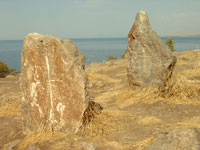 The Van lake is wonderful and has many different faces. In the eastern part, the water is deep blue and is surrounded by dry yellow mountains. In the south the water has carribic blue colours with fertile green banks. In the city of Van we visited the citadel and walked through the centre. After two nice days camping at the shore of the Van lake with Ingo and Renate from Germany we drove to Ahtamar Adase where, by boat, we visited an Armenian church ruin on a rock in the middle of the Van lake.
The Van lake is wonderful and has many different faces. In the eastern part, the water is deep blue and is surrounded by dry yellow mountains. In the south the water has carribic blue colours with fertile green banks. In the city of Van we visited the citadel and walked through the centre. After two nice days camping at the shore of the Van lake with Ingo and Renate from Germany we drove to Ahtamar Adase where, by boat, we visited an Armenian church ruin on a rock in the middle of the Van lake.
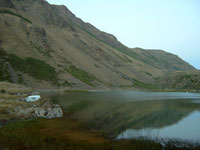 The next day we drove to the Nemrut Dagi volcano. Via a steep, winding asphalt road we got to the top of the volcano. The view over the giant crater with two volcano lakes in it was fantastic. Over a sandy road we drove into the crater till we reached a magnificent spot with view over the big, deep blue lake, surrounded by steep crater walls. Here we camped three days and enjoyed this spectacle of nature. However, when on the third day a Kurdish family came to practice shooting their Kalashnikov next to our car, we did not sleep very well anymore. The next day we drove via a rocky little road to the small green crater lake with its hot springs and we spent one more day here. We went to an ice grotto (volcanic activity) and then left the volcano.
The next day we drove to the Nemrut Dagi volcano. Via a steep, winding asphalt road we got to the top of the volcano. The view over the giant crater with two volcano lakes in it was fantastic. Over a sandy road we drove into the crater till we reached a magnificent spot with view over the big, deep blue lake, surrounded by steep crater walls. Here we camped three days and enjoyed this spectacle of nature. However, when on the third day a Kurdish family came to practice shooting their Kalashnikov next to our car, we did not sleep very well anymore. The next day we drove via a rocky little road to the small green crater lake with its hot springs and we spent one more day here. We went to an ice grotto (volcanic activity) and then left the volcano.
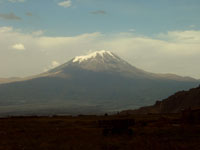 The next stretch with many police controls goes to Dogubayazit at the Iranian border. About 40 km distance from Van we looked at a nice waterfall and had a picknick with three policeman. The route was very special with a rough volcanic hill landscape and valleys filled with hardened black lava. On some places the lava seemed to come directly out of the ground. This must be a good film set for a Lord of the Rings-scene. The villagers practically used the lava to build their houses with.
The next stretch with many police controls goes to Dogubayazit at the Iranian border. About 40 km distance from Van we looked at a nice waterfall and had a picknick with three policeman. The route was very special with a rough volcanic hill landscape and valleys filled with hardened black lava. On some places the lava seemed to come directly out of the ground. This must be a good film set for a Lord of the Rings-scene. The villagers practically used the lava to build their houses with.
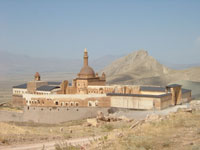 In Dogubayazit we went to the overlanders-campsite Murat and we spent a few nice days with Kristof, Julie and their two daughters from Belgium and Johann and Alex from Singapore. The Belgian family just came back from India (also with a Volkswagen LT) and they provided us with some very useful information. Kristof was lying in bed with malaria but after some medicines he got a bit better. We bbq-ed and we visited the Ishak Pasha Saray, the Dogubayazit caravansary, an impressive building in Islamic relief style with nice pillar rooms. In short, a few nice travellers-days before we headed to Iran.
In Dogubayazit we went to the overlanders-campsite Murat and we spent a few nice days with Kristof, Julie and their two daughters from Belgium and Johann and Alex from Singapore. The Belgian family just came back from India (also with a Volkswagen LT) and they provided us with some very useful information. Kristof was lying in bed with malaria but after some medicines he got a bit better. We bbq-ed and we visited the Ishak Pasha Saray, the Dogubayazit caravansary, an impressive building in Islamic relief style with nice pillar rooms. In short, a few nice travellers-days before we headed to Iran.
Coen
|
 |
|
 |
 |
 |
 |
Our top 6: |
 |
 |
1. Pamukkale
2. Cappadocie
3. Yalova
4. Dalyan
5. Tokat
6. Istanbul
|
 |
 |
 |
 |
 |
 |
 |
 |
TIP |
 |
 |
Diesel in Turkey may be of low quality, even be diluted with oil or water.
This may cause some strange rattling noises in your motor.
You can lessen these effects by getting your petrol in cities rather than in the countryside.
|
 |
 |
 |
 |
 |
 |
 |
 |
TIP |
 |
 |
In Trabzon, you no longer get visa for Russia, but you do get one month tourist visa for Iran within a week for only US$ 16.
Georgian visa for up to two weeks can be bought in Trabzon for US$ 70 (takes five minutes).
|
 |
 |
 |
 |
 |
 |
 |
 |
TIP |
 |
 |
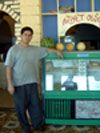
On the road between Belen and Antakya, just south of Belen, the Shell petrol station offers good camping and food behind the station.
Free of charge and the people are extremely friendly.
|
 |
 |
 |
 |
 |
 |
 |
 |
TIP |
 |
 |
Camping Kaya in Ortahisar: beautiful and new, with swimming pool and good facilities, right in the middle of Cappadocia!
|
 |
 |
 |
 |
 |
 |
|


